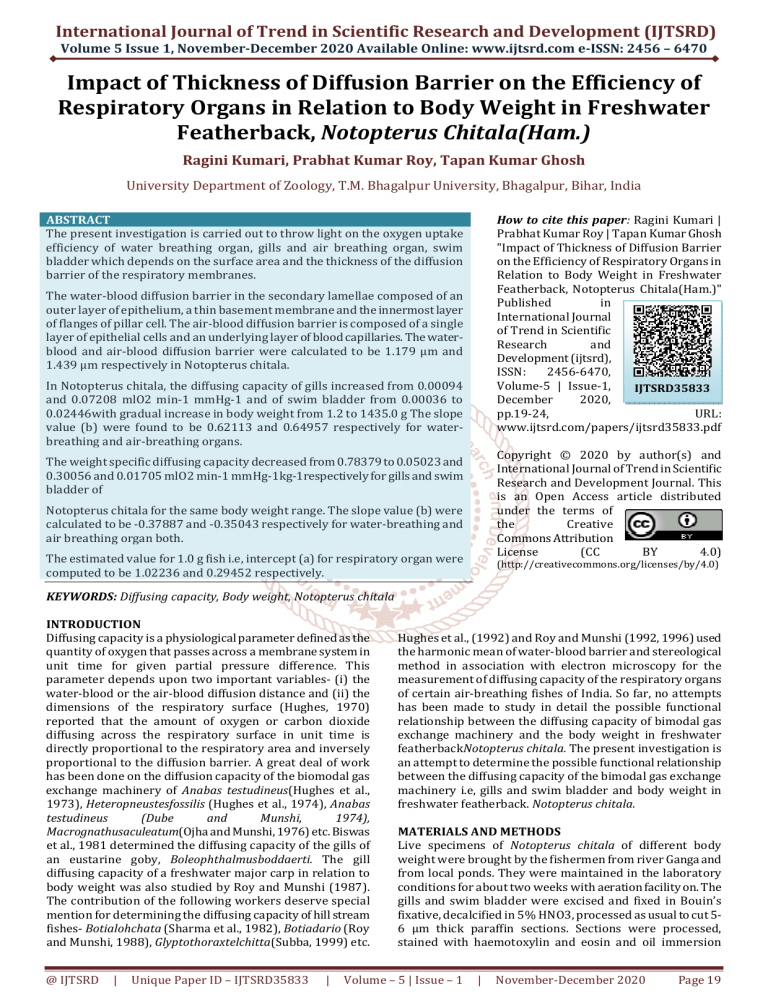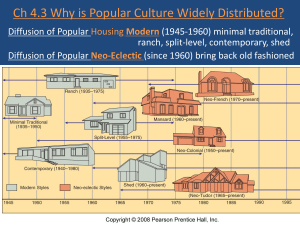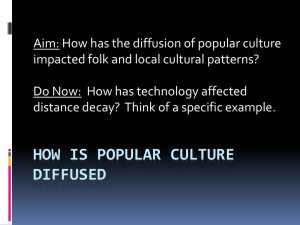
International Journal of Trend in Scientific Research and Development (IJTSRD)
Volume 5 Issue 1, November-December 2020 Available Online: www.ijtsrd.com e-ISSN: 2456 – 6470
Impact of Thickness of Diffusion Barrier on the Efficiency of
Respiratory Organs in Relation to Body Weight in Freshwater
Featherback, Notopterus Chitala(Ham.)
Ragini Kumari, Prabhat Kumar Roy, Tapan Kumar Ghosh
University Department of Zoology, T.M. Bhagalpur University, Bhagalpur, Bihar, India
How to cite this paper: Ragini Kumari |
Prabhat Kumar Roy | Tapan Kumar Ghosh
"Impact of Thickness of Diffusion Barrier
on the Efficiency of Respiratory Organs in
Relation to Body Weight in Freshwater
Featherback, Notopterus Chitala(Ham.)"
Published
in
International Journal
of Trend in Scientific
Research
and
Development (ijtsrd),
ISSN:
2456-6470,
Volume-5 | Issue-1,
IJTSRD35833
December
2020,
pp.19-24,
URL:
www.ijtsrd.com/papers/ijtsrd35833.pdf
ABSTRACT
The present investigation is carried out to throw light on the oxygen uptake
efficiency of water breathing organ, gills and air breathing organ, swim
bladder which depends on the surface area and the thickness of the diffusion
barrier of the respiratory membranes.
The water-blood diffusion barrier in the secondary lamellae composed of an
outer layer of epithelium, a thin basement membrane and the innermost layer
of flanges of pillar cell. The air-blood diffusion barrier is composed of a single
layer of epithelial cells and an underlying layer of blood capillaries. The waterblood and air-blood diffusion barrier were calculated to be 1.179 µm and
1.439 µm respectively in Notopterus chitala.
In Notopterus chitala, the diffusing capacity of gills increased from 0.00094
and 0.07208 mlO2 min-1 mmHg-1 and of swim bladder from 0.00036 to
0.02446with gradual increase in body weight from 1.2 to 1435.0 g The slope
value (b) were found to be 0.62113 and 0.64957 respectively for waterbreathing and air-breathing organs.
Copyright © 2020 by author(s) and
International Journal of Trend in Scientific
Research and Development Journal. This
is an Open Access article distributed
under the terms of
the
Creative
Commons Attribution
License
(CC
BY
4.0)
The weight specific diffusing capacity decreased from 0.78379 to 0.05023 and
0.30056 and 0.01705 mlO2 min-1 mmHg-1kg-1respectively for gills and swim
bladder of
Notopterus chitala for the same body weight range. The slope value (b) were
calculated to be -0.37887 and -0.35043 respectively for water-breathing and
air breathing organ both.
The estimated value for 1.0 g fish i.e, intercept (a) for respiratory organ were
computed to be 1.02236 and 0.29452 respectively.
(http://creativecommons.org/licenses/by/4.0)
KEYWORDS: Diffusing capacity, Body weight, Notopterus chitala
INTRODUCTION
Diffusing capacity is a physiological parameter defined as the
quantity of oxygen that passes across a membrane system in
unit time for given partial pressure difference. This
parameter depends upon two important variables- (i) the
water-blood or the air-blood diffusion distance and (ii) the
dimensions of the respiratory surface (Hughes, 1970)
reported that the amount of oxygen or carbon dioxide
diffusing across the respiratory surface in unit time is
directly proportional to the respiratory area and inversely
proportional to the diffusion barrier. A great deal of work
has been done on the diffusion capacity of the biomodal gas
exchange machinery of Anabas testudineus(Hughes et al.,
1973), Heteropneustesfossilis (Hughes et al., 1974), Anabas
testudineus
(Dube
and
Munshi,
1974),
Macrognathusaculeatum(Ojha and Munshi, 1976) etc. Biswas
et al., 1981 determined the diffusing capacity of the gills of
an eustarine goby, Boleophthalmusboddaerti. The gill
diffusing capacity of a freshwater major carp in relation to
body weight was also studied by Roy and Munshi (1987).
The contribution of the following workers deserve special
mention for determining the diffusing capacity of hill stream
fishes- Botialohchata (Sharma et al., 1982), Botiadario (Roy
and Munshi, 1988), Glyptothoraxtelchitta(Subba, 1999) etc.
@ IJTSRD
|
Unique Paper ID – IJTSRD35833
|
Hughes et al., (1992) and Roy and Munshi (1992, 1996) used
the harmonic mean of water-blood barrier and stereological
method in association with electron microscopy for the
measurement of diffusing capacity of the respiratory organs
of certain air-breathing fishes of India. So far, no attempts
has been made to study in detail the possible functional
relationship between the diffusing capacity of bimodal gas
exchange machinery and the body weight in freshwater
featherbackNotopterus chitala. The present investigation is
an attempt to determine the possible functional relationship
between the diffusing capacity of the bimodal gas exchange
machinery i.e, gills and swim bladder and body weight in
freshwater featherback. Notopterus chitala.
MATERIALS AND METHODS
Live specimens of Notopterus chitala of different body
weight were brought by the fishermen from river Ganga and
from local ponds. They were maintained in the laboratory
conditions for about two weeks with aeration facility on. The
gills and swim bladder were excised and fixed in Bouin’s
fixative, decalcified in 5% HNO3, processed as usual to cut 56 µm thick paraffin sections. Sections were processed,
stained with haemotoxylin and eosin and oil immersion
Volume – 5 | Issue – 1
|
November-December 2020
Page 19
International Journal of Trend in Scientific Research and Development (IJTSRD) @ www.ijtsrd.com eISSN: 2456-6470
photomicrographs were taken from various level. The
maximum and minimum diffusion distances were measured
directly from the photomicrographs and the actual values of
the diffusion distances were obtained by dividing the
measured thickness by magnification. The arithmetic and
harmonic means of diffusion distances were calculated.
Modified Fick’s equation (Hugher, 1972; Weibel, 1972) used
to calculate the diffusing capacity of the respiratory organs.
The modified Fick’s equation is as followsVO2 = K.A. Δ PO2
(i)
or, VO2/ΔPO2 = K.A./t
(ii)
or, Dt = K.A./t
(iii)
TO2 = VO2/ΔPO2
(iv)
Where,
VO2 = Oxygen uptake (mlO2.min-1)
K
= Krogh’s permeation coefficient tissve at 20⁰C i.e.,
0.00015 mlO2.cm-2.µm-1.min-1.mmHg-1)
A
= Respiratory (Gill/ swimbladder) surface Area (cm2)
taken from previous chapter of thesis.
ΔPO2 = Difference of oxygen tension between water/air and
blood (mmHg).
t
= thickness of water /air-blood pathway (µm)
The respiratory surface area, together with diffusion
distance and the value for permeation coefficient were
applied to equation (iii) to calculate the diffusing capacity
(Dt).Regression analysis using logarithmic transformation
was made to establish the relationship between the diffusing
capacity and body weight. The relationship was expressed by
the following allometric equationDt = aWb
Where,
Dt = Diffusing capacity
W = Body weight (g) of fish
a = Intercept (value for 1 g fish)
b = slope value
RESULTS
Water - blood diffusion barrier
The water – blood diffusion barrier in the secondary
lamellae consists of an outermost- single layer of epithelium,
middle–the basement membrane and innermost layer of
flanges of pillar cells. The harmonic mean (x̄ h) of the
thickness of water – blood diffusion barrier of different
region of secondary lamellae was calculated to be 1.179 µm,
while arithmetic mean of the data obtained for the thickness
was found to be 1.461 in Notopterus chitala.
Relationship between Body weight and Gill diffusion
capacity (Dt) (mlO2.min-1.mm Hg-1)
The diffusing capacity of the gills of Notopterus chitala
increased from 0.00094 to 0.07208 with increase in body
weight from 1.2 to 1435.0 g (Tab-1). Log-log plots of the
body weight and the diffusing capacity for 1st, 2nd, 3rd, 4th and
total gills arches gave straight lines with slopes of 0.61547,
0.61885, 0.63590, 0.63720 and 0.62113 respectively. (Tab-2
Fig-1). There was significant and positive correlation
between the two variables. The relationship may be
expressed as follow-
@ IJTSRD
|
Unique Paper ID – IJTSRD35833
|
Dt = 0.00102.W0.62113
Or log Dt = log 0.00102 + 0.62113 .log W
Relationship between Body weight and Weight specific
diffusion capacity (Dt1) (mlO2.min-1.mm Hg-1.Kg-1)
The relationship between the body weight and the weight
specific diffusion capacity of gills showed a highly significant
but negative correlation between them. The log-log plots of
the two variables gave a straight line with the slopes 0.38453, -0.38115, -0.36410, -0.36280 and -0.37887 for the
1st, 2nd, 3rd, 4th and total gill arches respectively (Tab 2 Fig 2).
The intercept ‘a’ values for all the four gill arches separately
and also when taken together were found to be 0.28317,
0.29013, 0.21813, 0.15367 and 1.02236 respectively. The
weight specific diffusing capacity for 1.0, 10.0, 100.0, 1000.0
and 2000.0 g were estimated to be 1.02236, 0.42730,
0.17860, 0.07465 and 0.05741 (mlO2.min-1.mmHg-1.Kg-1)
respectively (Tab 3). The relationship between total
diffusing capacity (Dt1) and body weight can be expressed by
following equation:
Dt1 = 1.02236.W-0.37887
Air – blood diffusion barrier
The air- blood diffusion barrier of Notopterus chitala
composed of a single layer of epithelial cells and an
underlying layer of blood capillaries. The harmonic mean
(x̄ h) of the thickness of air – blood diffusion barrier from
different regions of the swimbladderwas calculated to be
1.439 µm while arithmetic mean was found to be 1.851 µm
Relationship between Body weight and swimbladder
Diffusing capacity (Dt) (mlO2.min-1.mm Hg-1)
The swimbladder diffusing capacity (Dt) of Notopterus
chitala increased from 0.00036 to 0.02446 with increase in
body weight from 1.2 to 1435.0 g (Tab 1). The value for 1.0,
10.0, 100.0, 1000.0 and 2000.0 g fishes were found to be
0.00029, 0.00131, 0.00586, 0.02617 and 0.04105 (mlO2.min1.mmHg-1) respectively. The allometric equation for the two
variables could be expressed as
Dt = 0.00029.W0.64957
The log-log plot between the two variables gave a straight
line with a slope of 0.64957 and the intercept 0.00029.
Relationship between Body weight and the weight
specific swimbladder Diffusion capacity (Dt1) (mlO2.min1.mmHg-1.Kg-1)
The relationship between the two variables indicated a
highly significant but a negative correlation (r = 0.94453;
p<0.001). The log - log graph when plotted gave a straight
line with a slope of -0.35043 and the intercept obtained was
0.29452(Tab 2 Fig 3). The relationship between the two
variables could be expressed as –
Dt1 = 0.29452.W-0.35043
The weight specific diffusing capacity of swimbladder for 1.0,
10.0, 100.0, 1000.0 and 2000.0 g fishes were found to be
0.29452, 0.13142, 0.05865, 0.026617 and 0.02053 mlO2.min1.mm Hg-1.Kg-1 respectively (Tab 3).
Volume – 5 | Issue – 1
|
November-December 2020
Page 20
International Journal of Trend in Scientific Research and Development (IJTSRD) @ www.ijtsrd.com eISSN: 2456-6470
Table 1: Gill and swim bladder diffusing capacity for different weight groups of Notopterus chitala
Body weight (g)
Diffusion Capacity
Diffusion Capacity
Swim
Gill area
Bladder
(Dt)
(Dt1)
(Dt)
(Dt1)
(cm2)
Area
(mlO2/min (mlO2/min/
(mlO2/min (mlO2/min/
(cm2)
/mmHg)
mmHg/kg)
/mmHg)
mmHg/kg)
1.2
7.39270
0.00094
0.78379
3.46000
0.00036
0.30056
5.2
19.67084
.00250
0.48128
4.84000
0.00050
0.09702
9.8
28.09494
0.00357
0.36474
10.24000
0.00107
0.10892
17.9
48.83931
0.00621
0.34713
18.33000
0.00191
0.10674
32.0
77.02790
0.00980
0.30625
29.04000
0.00303
0.09460
50.0
108.95028
0.01386
0.27723
49.05000
0.00511
0.10226
82.5
156.90882
0.01996
0.24198
62.22000
0.00649
0.07862
100.0
175.72696
0.02236
0.22357
74.52000
0.00777
0.07768
136.0
230.86005
0.02937
0.21597
88.16000
0.00919
0.06757
190.0
231.77661
0.02949
0.15520
98.25000
0.01024
0.05390
251.0
240.57714
0.03061
0.12194
100.28000
0.01045
0.04165
525.0
332.47184
0.04230
0.08057
146.04000
0.01522
0.02900
1000.0
475.23577
0.06046
0.06046
206.38000
0.02151
0.02151
1435.0
566.52528
0.07208
0.05023
234.66000
0.02446
0.01705
Table 2: Intercept(a), slope(b) along with their standard error (S.E.) and correlation coefficient(r), of the
relationship of body weight and diffusing capacity Notopterus chitala.
Intercept(a)
Slope(b)
Body weight Vs
Correlation
diffusing capacity
Coefficient(r)
Value
S.E.
Value
S.E.
A .Gill
Dt.(mlO2/min/mmHg)
1st Gill Arch
0.00028 0.06681 0.61547 0.03289 0.98329 (p<0.001)
2nd Gill Arch
0.00029 0.06888 0.61885 0.03391 0.98245 (p<0.001)
rd
3 Gill Arch
0.00022 0.06034 0.63590
0.0297 0.98715 (p<0.001)
th
4 Gill Arch
0.00015 0.04789 0.63720 0.02358 0.99188 (p<0.001)
Total gill arches
0.00102 0.05540 0.62113 0.02727 0.98862 (p<0.001)
Dt1.(mlO2/min/mmHg/kg)
1st Gill Arch
0.28317 0.06681 -0.38453 0.03289 0.95879 (p<0.001)
2nd Gill Arch
0.29013 0.06888 -0.38115 0.03391 0.95564 (p<0.001)
rd
3 Gill Arch
0.21813 0.06034 -0.36410 0.02970 0.96230 (p<0.001)
th
4 Gill Arch
0.15367 0.04789 -0.36280 0.02358 0.97558 (p<0.001)
Total gill arches
1.02236 0. 0554 -0.37887 0.02727 0.97028 (p<0.001)
B. Swim Bladder
Dt.(mlO2/min/mmHg)
0.00029 0.07145 0.64957 0.03517 0.98285 (p<0.001)
Dt1.(mlO2/min/mmHg/kg) 0.29452 0.07145 -0.35043 0.03517 0.94453 (p<0.001)
Table 3: Computed diffusing capacity values for 1, 10, 100, 1000 and 2000 g fishes (Notopteruschitala) along with their.
Respiratory
organs
Dt.(mlO2/min
/mm Hg)
Dt1.(mlO2/min
/mmHg/kg)
Dt.(mlO2/min
/mm Hg)
Dt1.(mlO2/min
/mmHg/kg)
Total Gill
Arches
Swim
Bladder
@ IJTSRD
Diffusing
capacity
|
1g
Value
0.00102
1.02236
0.00029
0.29452
95%
C.L.
0.00077
0.00135
0.77429
1.34661
0.00021
0.00042
0.20580
0.42149
Unique Paper ID – IJTSRD35833
10g
Value
0.00427
0.42730
0.00131
0.13142
|
95%
C.L.
0.00282
0.00647
0.28224
0.64694
0.00077
0.00224
0.07698
0.22438
100g
Value
0.01786
0.17860
0.00586
0.05865
Volume – 5 | Issue – 1
1000g
95%
C.L.
0.01029
0.03100
0.10288
0.31004
0.00288
0.01195
0.02879
0.11945
|
Value
0.07465
0.07465
0.02617
0.2617
95%
C.L.
0.03750
0.14858
0.03750
0.14858
0.01077
0.06359
0.01077
0.06359
2000g
Value
0.11481
0.05741
0.04105
0.02053
November-December 2020
95%
C.L.
0.05535
0.23815
0.02768
0.11907
0.01602
0.10520
0.00801
0.5260
Page 21
International Journal of Trend in Scientific Research and Development (IJTSRD) @ www.ijtsrd.com eISSN: 2456-6470
Fig 1. Log/log plots showing the relationship between body weight and diffusing capacity of N.chital
Fig 2. Log/log plots showing the relationship between body weight and weight specific diffusing capacity of
N.chitala.
Fig 3. Log-log plot showing body weight and diffusing capacity (Dt, mlO2.min-1.mmHg-1) and (Dt1, mlO2.min1.mmHg-1Kg-1) of swimbladder in Notopterus chitala.
@ IJTSRD
|
Unique Paper ID – IJTSRD35833
|
Volume – 5 | Issue – 1
|
November-December 2020
Page 22
International Journal of Trend in Scientific Research and Development (IJTSRD) @ www.ijtsrd.com eISSN: 2456-6470
DISCUSSION
Hughes (1970) has shown that the thickness of diffusion
barrier varies greatly in its dimension with the activity of
fishes and ecological condition of the habitat. The waterblood diffusion distance was very low (0.533 to 0.598µm) in
very active fishes like Thunnusalbacares reported by Hughes
(1970). In Notopterus chitala the water- blood diffusion
distance was measured to be 1.179 which is closer to Indian
water breathing fishes like Cirrhinusmrigala (1.290µm, Roy
and Munshi, 1987), juveniles of Labeorohita (1.32µm,
Pandey, 1988) etc. However, the value of diffusion distance
of gills of Notopterus chitala was quite thin when compared
with Indian air-breathing fishes viz, 3.58µm in
Heteropneustesfossilis (Hughes et al., 1974);7.67µm in
Clariasbatrachus (Sinha, 1977);2.03µm in Channa punctatus
(Hakim et al., 1978) and 6.978µm inChannastriata
(Chaudhary, 1979) and 1.327µm in Notopterus notopterus
(Kumari, 2003). From this finding, it can be inferred that the
gill for gaseous exchange is more efficient in comparision to
most of the air breathing fishes.
The slope of the regression line (b) of the diffusing capacity
(Dt) of Notopterus chitala increases by a power of 0.62113
with unit increase in body weight. As, the slope value is less
than one, thus the weight specific diffusion capacity
(Dt1)decreases by a power of -0.37887 with increase in body
weight. It is evident from the above findings that the gills of
smaller fishes are more efficient than higher weight group of
fishes. Variations in the slopes of the regression lines of
different gill arches due to heterogenous growth patterns of
different gill arches.
The value of weight specific diffusing capacity (Dt1) for 100 g
of N. chitala was found to be 0.17860 which is closer to the
value of hill stream fish Glyptothoraxtelchitta (0.1675, Subba,
1999) but lower than Garralamta (0.1982, Rooj, 1984).
When this value was compared with purely water breathing
fishes, it was found to be lower than Cirrhinusmrigala
(0.5891, Roy and Munshi, 1986), Cattacatta (0.7416,
Kunwar, 1984) and Labeorohita (0.3061, Pandey,
1988).However, the value calculated for N. chitala was
higher than most of the Indian air-breathing fishes viz.
Anabas testudineus (0.0071, Hughes et al., 1973, ) Channa
punctatus (0.0530, Hakim et al., 1978), Channagachua
(0.0382, Dandotia, 1978) and Heteropneustesfossilis (0.0242,
Hughes et al., 1974).Similary, the value is higher than
another featherback, Notopterus notopterus (0.15505,
Kumari, 2003). These findings suggest the better oxygen
uptake efficiency of this fish in comparison to most of the
Indian air-breathing fish.
AIR-BLOOD DIFFUSION DISTANCE
The diffusion barrier of the swimbladder of Notopterus
chitala was calculated to be 1.439 which is quite thick in
comparison to the diffusion barrier of the gill (1.179). This
finding clearly indicates that the water breathing organ
provides better respiratory surface to this fish. Similar trend
has been observed when compared with Notopterus
notopterus (1.705 as air-blood diffusion distance and 1.327
as water – blood diffusion distance, Kumari, 2003). However,
the value (1.439) is very close to the value of the accessory
respiratory organ of Channastriata (1.359, Hughes and
Munshi, 1973 b). The air-blood diffusion distance of N.
chitala is higher than the other air- breathing fishes like.
Amphipnouscuchia (0.435, Hughes and Munshi, 1973),
@ IJTSRD
|
Unique Paper ID – IJTSRD35833
|
Clariasbatrachus (0.550, Sinha, 1977), Anabas testudineus,
Channa punctatus (0.21 and 0.78 respectively, Hughes and
Munshi, 1973 a), Channagachua (0.080, Dandotia, 1978).
Thus, the air- breathing organ of N. Chitala is less efficient in
gaseous exchange as compared to most of the air-breathing
fishes of India except Heteropneustesfossilis (1.605µm) and
Notopterus notopterus (1.705µm).
It is evident from the computed data on the regression lines
of the diffusing capacity (Dt) that in this featherback,
diffusing capacity increases by a power of 0.64957. The
weight specific diffusing capacity of the swimbladder for a
100 g Notopterus chitala was found to be 0.05865 which is
less than the value obtained for the gills (0.17860). The
above finding clearly indicates that the gills of N.chitala is
more efficient in gaseous exchange than the swimbladder.
This value (0.05865) was found to be closer to the
respiratory membrane of the suprabranchial chamber of a
100 g Anabas testudineus (0.0539, Hughes et al., 1973).
However, the value is higher than the air- breathing organs
of most of the air-breathing fishes like Amphipnouscuchia
(0.165, Hughes et al., 1974 b), Channagachua (0.0366,
Dandotia, 1978) Heteropneustesfossilis (0.0288, Hughes et al.,
1974 a) etc. except the dendritic organ of Clariasbatrachus
(0.0773, Hughes et al., 1974 b ) and suprabranchial chamber
of Channa punctatus0.0753, Hakim et al., 1978). Hence, it is
clear that the swimbladder of Notopterus chitala is more
efficient in comparison to most of the air-breathing fishes.
The morphometrically calculated VO2 for a 100 g N. chitala
was found to be 1071.6 through gills and 351.9 through
swimbladder is much higher than the actual oxygen uptake
(31.385 through gills and 82.069 through swimblader) (
Kumari, 2003). Hence, in N. chitala the oxygen uptake
through gills and swimbladder is almost 34 and 4 times
higher respectively than the actual oxygen uptake at 27.5 ±
1.0⁰C. A 5-10 times more oxygen uptake by the fishes in
active condition was reported by Alexander (1967). Thus, it
can be inferred that the morphometrically estimated oxygen
uptake may be the maximum oxygen uptake capacity of the
fish.
ACKNOWLEDGEMENT
The authors thankfully acknowledge the financial support to
this work by Indian Council of Agricultural Research [ICAR
(No.4 (5)/89-ASR-I)] and Council of Scientific and Industrial
Research [CSIR (No.37 (793)/91-EMR-II], New Delhi.
REFERENCES
[1] Alexender, R. M. (1967); Respiration Chapter 4, In
“Functional design in fishes”. pp 65-88. Hucthinson
and Co. Ltd. London.
[2]
Biswas, N., Ojha, J. and Munshi, J. S. D. (1981):
Morphometrics of the respiratory organs of an
eustarine goby, Boleophthalmusboddaerti, Japan. J.
Ichthyol., 27(4): 316-326.
[3]
Choudhary, D. P. (1979): Some aspect of respiratory
physiology of Channastriata (Bloch), (Channidae,
Channiformes). Ph. D. Thesis, Bhagalpur University,
Bhagalpur, India. 105p.
[4]
Dandotia, O. P. (1978): Studies on the functional
capacity of respiratory organs of a freshwater
amphibious fish, Channa(=Ophiocephalus) gachua
Volume – 5 | Issue – 1
|
November-December 2020
Page 23
International Journal of Trend in Scientific Research and Development (IJTSRD) @ www.ijtsrd.com eISSN: 2456-6470
(Ham.). Ph.D Thesis, Bhagalpur University, Bhagalpur,
India.
[5]
[6]
[7]
[8]
Dube, S. C. and Munshi, J. S. D. (1974): Studies on the
blood-water diffusion barrier of secondary gill
lamellae of an air-breathing fish, Anbastestudineus.
Zool. Anz., 193: 35-41.
Hakim, A., Munshi, J. S. D., and Hughes, G.M. (1978):
Morphometrics of the respiratory organs of the Indian
green snake headed fish, Channa punctate. J. Zool.,
Lon. 184: 519-543.
Hughes, G. M. (1970): Ultra structure of the air
breathing organs of some lower vertebrates.
7thInternat. Cong. Electron Microsc., Grenoble, pp.
599-600.
Hughes, G. M. (1972 b): Distribution of oxygen
tensions in the blood and water along the secondary
lamellae of ice fish gills. J. Exp. Biol., 56: 481-492.
[9]
Hughes, G. M., Dube, S. C. and Munshi J. S. D. (1973):
Surface area of the respiratory organs of the climbing
perch, Anabustestudineus.J.Zool., Lond. 170: 227-243.
[10]
Hughes, G.M. and Munshi, J. S. D. (1973 a): Fine
structure of the respiratory organs of the climbing
perch, Anabustestudineus(Pisces: Anabantidae). J.
Zool., Lond. 170: 201-225.
[11]
Hughes, G. M. and Munshi, J. S. D. (1973 b): Nature of
the air breathing organs of the Indian fishes, Channa,
Amphipnous, ClariasandSaccobranchus as shown by
electron microscopy. J. Zool., Lond. 170: 245-270.
[12]
Hughes, G. M., Roy, P. K. and Munshi, J. S. D. (1992):
Morphomeric estimation of oxygen diffusing capacity
for the air-sac in Heteropneustesfossilis. J. Zool., Lond.
227: 193-209.
[13]
Hughes, G. M., Singh, B. R., Guha, G., Dube, S.C. and
Munshi, J. S. D.(1974a): Respiratory surface area of an
air-breathing siluroid fish Saccobranchus (=
Heteropneustesfossilis in relation to body size. J.Zool.,
Lond.172:215-232.
[14]
[15]
[16]
Hughes, G. M., Singh, B. R., Thakur, R. N. and Munshi,
J. S. D (1974b): Areas of the air-breathing surfaces of
Amphipnouscuchia(Ham.) Proc. Indian. Natn.Sci.
Acad.40B:379-392.
Kumari, R. (2003): General organization and scaling
pattern of the respiratory organs in relation to body
weight
in
a
freshwater
featherback,
Notopteruschitala(Ham.). Ph. D. Thesis, T.M.
Bhagalpur University, Bhagalpur, India.
Kunwar, G. K. (1984): The structure and function of
the respiratory organs of a major carp
Catlacatla(Ham.). Ph.D. Thesis, Bhagalpur University,
Bhagalpur, India
@ IJTSRD
|
Unique Paper ID – IJTSRD35833
|
[17]
Ojha, J. and Munshi, J. S. D. (1976): Morphometric
estimation of gill diffusing capacity of a freshwater
mud eel, Macrognatusaculeatum(Bloch.) in relation to
body weight .Zool. Beitr., 22:87-98.
[18]
Pandey, A. (1988): The structure and function of the
respiratory
organs
of
a
major
carp
Labeorohita(Ham.). Ph.D. Thesis of Bhagalpur
University, Bhagalpur, India.
[19]
Rooj, N. C. (1984): Structure and function of the
respiratory organs of certain hill-steam fishes of
Chhotanagpur division. Ph.D. Thesis, Bhagalpur
University, Bhagalpur, India.
[20]
Roy, P. K. and Munshi, J. S. D. (1986): Morphometrics
of the respiratory organs of freshwater major carp,
Cirrhinusmrigala in relation to body weight. Japan.
J.Ichthyol.33:269-279.
[21]
Roy, P. K. and Munshi, J. S. D.(1987):Diffusing capacity
(Oxygen uptake efficiency) of gills of a freshwater
major carp, Cirrhinusmrigala ((Ham.)in relation to
body weight . Proc. Indian. Natn. Sci.Acad., B 53 (4) :
305-316.
[22]
Roy, P. K. and Munshi, J. S. D. (1992): Morphometric
assessment of accessory respiratory surface area and
their diffusing capacity in an adult snakeheaded fish,
Channastriata (Bloch). J. Freshwater Biol. 4 (2): 99107.
[23]
Roy, P. K. and Munshi, J. S. D. (1996): Morphometrics
of the respiratory system of air- breathing fishes of
India. In: “Fish Morphology: Horizon of New
Research” (J. S. D. Munshi and H.M. Dutta eds.) pp
203-234. Oxford & IBH Publishing Co. Pvt. Ltd., New
Delhi, Calcutta.
[24]
Sharma, S. N., Guha, G. and Singh B. R. (1982): Gill
dimensions of a Hill- stream fish, Botialohachata
(Pisces: Cobitidae).Proc. Indian natn. Sci. Acad.
B.48(1):81-91.
[25]
Sinha, A. L. (1977): On the structure and function of
the respiratory apparatus of certain teleostean fishes.
Ph.D. Thesis, Bhagalpur University, Bhagalpur, India.
[26]
Subba, B. R. (1999): Structure and function of the
respiratory organ of a hill stream fish,
Glyptothoraxtelchitta (Ham.) from Nepal, Ph. D.
Thesis, T.M. Bhagalpur University, Bhagalpur, India,
75p.
[27]
Weibel, E. R. (1972): Morphometric estimation of
pulmonary diffusion capacity. V.Comparative
morphometry of alveolar lungs. Respir. Physiol.,
14:26-43.
Volume – 5 | Issue – 1
|
November-December 2020
Page 24




